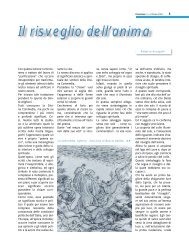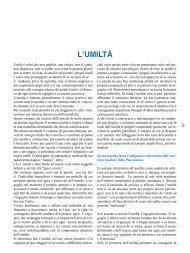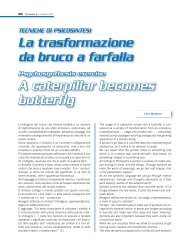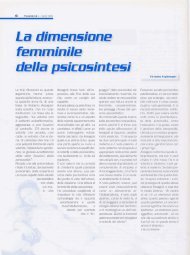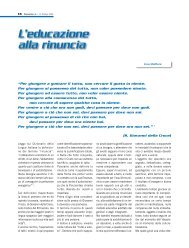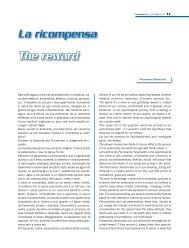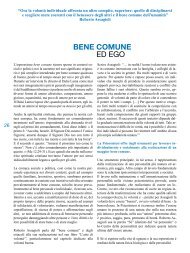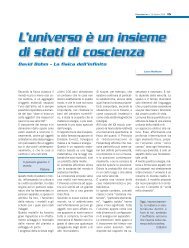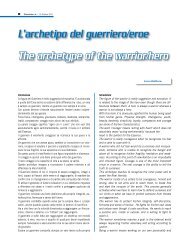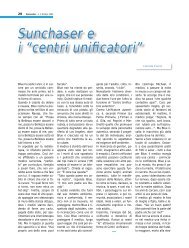La funzione psicosintetica della danza - Istituto di psicosintesi
La funzione psicosintetica della danza - Istituto di psicosintesi
La funzione psicosintetica della danza - Istituto di psicosintesi
You also want an ePaper? Increase the reach of your titles
YUMPU automatically turns print PDFs into web optimized ePapers that Google loves.
16 Psicosintesi < n. 15 Aprile 2011<br />
<strong>La</strong> <strong>funzione</strong> <strong>psicosintetica</strong><br />
<strong>della</strong> <strong>danza</strong><br />
The psychosyntetic<br />
function of dancing<br />
<strong>La</strong> tendenza <strong>della</strong> cultura moderna verso una cooperazione<br />
inter<strong>di</strong>sciplinare rispecchia la complessità che l’uomo<br />
d’oggi ha raggiunto a livello fisico e psicologico.<br />
L’uomo moderno ha acquisito un predominio sul mondo<br />
esterno tale che non solo ha molto tempo libero, ma può<br />
permettersi il lusso <strong>di</strong> esplorare le infinite possibilità create<br />
per riempirlo. Eppure, l’indecisione, il malcontento, la<br />
noia, restano ad in<strong>di</strong>care che egli non ha ancora compreso<br />
e dominato il fondo <strong>di</strong> tutto il suo potere, <strong>della</strong> sua creatività<br />
e <strong>della</strong> sua volontà, vale a <strong>di</strong>re il fondo <strong>di</strong> un’esistenza<br />
significativa che vada oltre il “principio del piacere”.<br />
È l’io interiore che è stato trascurato, l’uomo ha creato una<br />
cultura tecnologicamente perfetta, sì, ma che lo ha lasciato<br />
insod<strong>di</strong>sfatto. Il suo slancio verso le cose sacre, misteriose<br />
e belle, è stato interrotto se non totalmente <strong>di</strong>strutto da<br />
questa cultura piena <strong>di</strong> ritmi meccanici non umani.<br />
L’impulso verso la riscoperta dell’armonia naturale, la ricostituzione<br />
<strong>di</strong> un ritmo equilibrato e la riconciliazione<br />
dell’attività umana col <strong>di</strong>segno cosmico, sono gli elementi<br />
dai quali la <strong>danza</strong> nacque agli inizi <strong>della</strong> civiltà, e dai quali<br />
si può ripartire per la sua applicazione terapeutica.<br />
Oggi, più che in passato, le arti non possono rimanere solo<br />
fini a se stesse. Ogni scelta <strong>di</strong>sponibile deve essere applicata<br />
alla scoperta dell’Io e <strong>della</strong> sua creatività. Siccome<br />
l’intero corpo è permeato dall’impulso vitale verso l’avvenire,<br />
l’arte che tratta specificamente <strong>della</strong> realizzazione<br />
del corpo, cioè la <strong>danza</strong>, può essere un mezzo utile per la<br />
scoperta del nostro Io e la contemporanea coor<strong>di</strong>nazione <strong>di</strong><br />
tutte le nostre facoltà creative.<br />
Questo Io interiore è quella parte che prova l’esperienza<br />
<strong>della</strong> vita e la prova attraverso il corpo fisico. <strong>La</strong> prima sensazione<br />
tattile è quella del contatto del bambino con il corpo<br />
<strong>della</strong> madre. Non si può sottovalutare l’importanza del<br />
Christine Mallouk<br />
L’ARCHIVIO<br />
The trend of modern culture towards an inter<strong>di</strong>sciplinary cooperation<br />
reflects the complexity that today’s man reached at<br />
physical and psychological level.<br />
The modern man acquired such a predominance on the external<br />
world. Man has nowadays a lot of free time and can afford<br />
exploring the endless possibilities created in order to spend<br />
this free time. In spite of this indecision, unhappiness and<br />
boredom point out that man has not yet totally understood<br />
and dominated his power, creativeness and will, thus the core<br />
of a meaningful existence, which goes beyond the “principle<br />
of pleasure.”<br />
Internal Self has been neglected, man created a technologically<br />
perfect culture, but he is still unsatisfied. His rush towards<br />
sacred, mysterious and beautiful things, has been interrupted<br />
and nearly destroyed by this culture full of non-human<br />
mechanical rhythms.<br />
The impulse toward the re<strong>di</strong>scovery of natural harmony, the<br />
re-creation of a balanced rhythm and the reconciliation of<br />
the human activity with the cosmic scheme, are the elements<br />
from which dancing was born at the beginning of civilization,<br />
and starting using these elements once more can be a<br />
therapeutic.<br />
Today, more than in the past, arts cannot remain merely the<br />
ultimate aim. All available choices must be applied to the<br />
<strong>di</strong>scovery of the Self and its creativity. Since the whole body<br />
is permeated by the vital impulse toward future, dancing, the<br />
art that specifically draws some realization of the body, can be<br />
a useful mean in order to <strong>di</strong>scover our Self and the contemporary<br />
coor<strong>di</strong>nation of all of our creative faculties.<br />
Inner Self is the part that tests the experience of life through<br />
physical body. The first tactile feeling is the contact of the<br />
child with his mother’ s body. Body’ s importance cannot be<br />
underestimated: it is not only a tool of physical perception, but
DELLA MEMORIA<br />
Psicosintesi < n. 15 Aprile 2011 17<br />
corpo non soltanto come strumento <strong>della</strong> percezione fisica,<br />
ma anche come il me<strong>di</strong>atore fra la coscienza umana ed il<br />
mondo esterno. Il corpo è dopo tutto il primo punto <strong>di</strong> riferimento<br />
per stabilire un’identità, un’immagine <strong>di</strong> sé. Come<br />
tale, i suoi ritmi e poteri recettivi costituiscono un modello<br />
per tutte le nostre esperienze oltre quelle puramente fisiche:<br />
le emozioni, la logica del pensiero, la sottigliezza delle<br />
intuizioni, rispecchiano in un modo o nell’altro il modo iniziale<br />
in cui il corpo riceve e comunica le sensazioni. Perciò<br />
la nostra meta è <strong>di</strong> creare una terapia, una vera e propria<br />
psicologia che utilizza la <strong>danza</strong> come mezzo per armonizzare<br />
i <strong>di</strong>fferenti elementi <strong>della</strong> personalità.<br />
Il corpo può essere pensato come una manifestazione<br />
<strong>della</strong> coscienza in<strong>di</strong>viduale,<br />
la psiche personale esterna;<br />
esso è ricettivo, trasformabile<br />
e malleabile.<br />
A riposo, il corpo è simile ad<br />
un’opera d‘arte quadri<strong>di</strong>mensionale,<br />
un’estensione <strong>di</strong>namica<br />
dell’incrocio <strong>di</strong> spazio,<br />
tempo ed intenzione umana.<br />
Può sembrare passivo, ma al<br />
livello inconscio esso partecipa<br />
attivamente alla vitalità<br />
dell’universo fisico: esso<br />
partecipa agli scambi e alle<br />
trasformazioni fra materia ed<br />
energia nell’universo. Assorbe<br />
ossigeno ed elimina anidride<br />
carbonica, contribuendo continuamente<br />
all’equilibrio delle<br />
sostanze chimiche, non solo<br />
entro il suo ambiente qualificato,<br />
ma influenzando anche<br />
l’equilibrio fra gli elementi<br />
inter<strong>di</strong>pendenti nell’ambiente<br />
esterno, fra l’uomo e l’uomo e<br />
fra gli uomini e la natura.<br />
Il corpo è sempre in movimento,<br />
sposta aria, emana<br />
also as me<strong>di</strong>ator between human conscience and the external<br />
world. After all, body is the first point of reference to establish<br />
an identity, an image of ourselves. As such, its rhythms and<br />
receptive powers constitute a model for all of our experiences<br />
over those purely physical: emotions, logic of mind, thinness<br />
of intuitions, in one way or another reflect how body receives<br />
and communicates feelings in first place. Therefore our goal is<br />
creating a therapy, a real psychology, that employs dancing as<br />
a mean to harmonize <strong>di</strong>fferent elements of personality.<br />
We can think of body as a manifestation of in<strong>di</strong>vidual conscience,<br />
the external personal psyche; it is receptive, transformable<br />
and malleable.<br />
While resting, body is similar to a four <strong>di</strong>mensions artwork, a<br />
dynamic extension of the intersection<br />
of space, time and<br />
human intention. It could be<br />
seen as passive, but, in an<br />
unconscious level, it actively<br />
and vitally participates of the<br />
physical universe: it takes<br />
part in changes and transformations<br />
between substance<br />
and energy in the universe.<br />
It absorbs oxygen and eliminates<br />
carbon <strong>di</strong>oxide, and it<br />
is continuously contributing<br />
in order to balance chemical<br />
substances, not only within<br />
its qualified environment,<br />
but also influencing the balance<br />
between interdependent<br />
elements in the external environment,<br />
between men and<br />
between men and nature.<br />
Body is always in movement. It<br />
moves air, emanates streams<br />
of strength, creates forms not<br />
only with the change of its<br />
parts, but with the void that<br />
these parts create when leave<br />
a space and fill another one<br />
correnti <strong>di</strong> forza, crea forme Edgar Degas “Scuola <strong>di</strong> Ballo” 1874 in the field of movement.<br />
non soltanto con il cambia-<br />
Louvre- Parigi<br />
Energy irra<strong>di</strong>ating from the<br />
mento delle sue parti, ma col<br />
body has also infinite varying<br />
vuoto che queste parti creano<br />
effects on those people who<br />
quando lasciano uno spazio e ne riempiono un altro nel surround it. Have you ever felt in a ‘physical’ way a person’s<br />
campo <strong>di</strong> movimento.<br />
presence, although you don’t see him/her ? This shows both<br />
L’energia che esso emana ha anche effetti infinitamente body’s receptiveness and its power into communicating. We<br />
variabili su coloro che lo circondano. Avete mai sentito in are sensitive to the vital qualities of other people, also without<br />
maniera ‘fisica’ la presenza <strong>di</strong> una persona, anche se non a meaningful change in their physical attitude. I consider these<br />
la vedete? Questo <strong>di</strong>mostra sia la ricettività del corpo sia manifestations as expressions of personality and inner Self.<br />
il suo potere <strong>di</strong> comunicare. Siamo sensibili alle qualità Our movements start as simple imitation. The rhythm of such<br />
vitali d’altre persone, anche senza un cambiamento signi- movements is vital as life itself. We are sensitive to the rhythm<br />
ficativo nel loro atteggiamento fisico. Io ritengo queste ma- since our conception and we develop some mental and emonifestazioni<br />
come espressione <strong>della</strong> personalità e del Sé tional trend by floating rhythms within the protective environ-<br />
interiore.<br />
ment of the uterus.
18 Psicosintesi < n. 15 Aprile 2011<br />
I nostri movimenti iniziano per semplice imitazione. Il ritmo<br />
<strong>di</strong> tali movimenti è vitale quanto lo è la vita stessa. Siamo<br />
sensibili al ritmo dal momento del nostro concepimento e<br />
sviluppiamo certe tendenze mentali ed emotive per mezzo<br />
dei ritmi oscillanti dell’ambiente protettivo dell’utero.<br />
Siamo nati con tutto quello <strong>di</strong> cui abbiamo bisogno per<br />
eseguire i movimenti essenziali che stabiliscono i rapporti<br />
umani, ma dobbiamo evolvere, per mezzo dell’allenamento<br />
creativo, verso una modalità <strong>di</strong> muoverci veramente in<strong>di</strong>viduato<br />
e personale. Così i nostri corpi manifesteranno<br />
ciò che è chiamato stile, una vera espressione del nostro<br />
essere interiore, un’accurata rappresentazione dell’intera<br />
personalità.<br />
<strong>La</strong> <strong>danza</strong> come strumento terapeutico<br />
Dal momento che il corpo è una parte costitutiva <strong>della</strong> personalità,<br />
l’in<strong>di</strong>viduo deve per prima cosa imparare a rispettare<br />
e riconoscere quegli aspetti del suo essere fisico che<br />
possono creare in seguito legami con i suoi stati interiori. Il<br />
corpo è facilmente malleabile, per questo è un buon punto<br />
<strong>di</strong> partenza per lo sviluppo <strong>di</strong> una più positiva immagine <strong>di</strong><br />
sé. È uno strumento me<strong>di</strong>ante il quale è possibile giungere<br />
ad una genuina e concreta realizzazione del Sé interiore.<br />
<strong>La</strong> <strong>danza</strong>terapia è basata sul fatto che i <strong>di</strong>sturbi psichici<br />
si manifestano in mo<strong>di</strong> palesi e sottili con sintomi e gesti<br />
fisici. Il modo in cui una persona si muove può essere<br />
un’in<strong>di</strong>cazione del suo stato psicologico, <strong>di</strong> tensione o <strong>di</strong><br />
calma per esempio.<br />
<strong>La</strong> <strong>danza</strong> può condurre al ristabilimento dei ritmi primitivi,<br />
vale a <strong>di</strong>re al ristabilimento dell’armonia psichica e<br />
all’equilibrio delle energie fisiche. Questo facilita la creatività<br />
ed il consumo minimo dell’energia <strong>di</strong>retta al raggiungimento<br />
<strong>di</strong> una meta.<br />
Per mezzo d’esercizi volti a scoprire i centri <strong>di</strong> equilibrio<br />
e l’armonizzazione <strong>della</strong> respirazione con il movimento, il<br />
soggetto impara ad apprezzare l’importanza <strong>della</strong> volontà<br />
per l’azione. Egli impara a concentrare l’intero suo essere<br />
sull’esecuzione <strong>di</strong> movimenti coor<strong>di</strong>nati. In seguito, tali<br />
movimenti <strong>di</strong>vengono più o meno spontanei secondo il grado<br />
<strong>di</strong> fiducia nel proprio corpo che egli sviluppa. Questa<br />
fiducia nel proprio essere fisico stabilirà il giusto atteggiamento<br />
dell’in<strong>di</strong>viduo nei suoi rapporti con gli altri.<br />
Il respiro è normalmente un’attività inconscia, ma concentrarsi<br />
sulla sua sorgente e sugli effetti che produce sui<br />
movimenti, è un esercizio importante che conduce alla<br />
consapevolezza d’altri processi e potenziali inconsci. <strong>La</strong><br />
riassociazione iniziale <strong>della</strong> coscienza dal corpo fisico in<br />
movimento, al fine <strong>di</strong> riflettere e <strong>di</strong> valutarlo giustamente,<br />
sembra un passo necessario per ottenere la reintegrazione<br />
del movimento all’interno dell’intera personalità.<br />
Oltre ai movimento in<strong>di</strong>viduali e personali, esiste un altro<br />
tipo <strong>di</strong> movimento che deriva dalle sorgenti <strong>della</strong> creatività<br />
artistica, espressione o intuizione <strong>di</strong> motivi universali. Non<br />
è sempre prodotto consapevolmente, ma può essere evocato<br />
da una coscienza altamente sensibile alla comunicazione<br />
ritmica, entro un corpo il cui allenamento ha prodotto la<br />
capacità <strong>di</strong> esprimersi attraverso simboli fisici (analoghi ai<br />
We were born with everything we have need to perform the essential<br />
movements that establish human relationships, but we<br />
must evolve through creative training, towards a way to make<br />
us moving in a in<strong>di</strong>vidual and personal way. In this way our<br />
bo<strong>di</strong>es will manifest what it is called style, a true expression<br />
of our internal being, an accurate representation of the whole<br />
personality.<br />
Dancing as therapeutic tool<br />
Since body is a constitutive part of personality, in<strong>di</strong>vidual must<br />
in first place learn to respect and to recognize those aspects of<br />
his physical being, which can create ties with his inner states.<br />
Body is easily malleable; for this reason it is a good starting<br />
point for developing a more positive image of ourselves. It is a<br />
tool by which it is possible to come to a genuine and concrete<br />
realization of the inner Self.<br />
The “dancetherapy” is based on the fact that psychic troubles<br />
are manifested in clear and thin ways by symptoms and<br />
physical gestures. The way how a person moves can be an<br />
in<strong>di</strong>cation of his psychological state, for example of tension<br />
or of stillness.<br />
Dancing can bring to the reestablishment of primitive rhythms,<br />
that is to say reestablishing psychic harmony and equilibrium<br />
of physical energies. This facilitates creativity and a lowest<br />
consumption of energy necessary for attaining a goal.<br />
Through exercises <strong>di</strong>rected to <strong>di</strong>scover centers of equilibrium<br />
and harmonization between breathing and moving, the subject<br />
learns to appreciate the importance of will for action. He<br />
learns to concentrate the whole of his being on the execution<br />
of coor<strong>di</strong>nated movements. Subsequently, such movements<br />
become more or less spontaneous accor<strong>di</strong>ng to the degree of<br />
trust in his own body that he is developing. This trust in his<br />
own physical will establish the correct attitude of the in<strong>di</strong>vidual<br />
in its relationships with the others.<br />
Breathing is normally an unconscious activity, but, focusing<br />
on its source and on the effects that it produces on movements,<br />
is an important exercise, which brings to the awareness<br />
of other processes and of unconscious potential. The<br />
initial re-association of the conscience from the physical body<br />
in movement, in order to reflect and to correctly appraise it,<br />
seems a necessary step to get the reinstatement of the movement<br />
inside the whole personality.<br />
Besides the in<strong>di</strong>vidual and personal movements, another type<br />
of movement exists and it derives from the sources of artistic<br />
creativity, expression or intuition of universal motives. It is<br />
not always produced in a conscious way, but it can be evoked<br />
by a sensitive conscience to rhythmic communication, inside<br />
a body, whose training produced the ability to express itself<br />
through physical symbols (similar to the figurative symbols of<br />
other arts), that is the forms of choreographies.<br />
The objective of dancing, as therapeutic tool, would be the<br />
fusion and the coor<strong>di</strong>nation of particular powers of expression<br />
of Self and ideas, and the integration of the image of the body<br />
with the image of the Self.<br />
We can be sure that in<strong>di</strong>vidual will acquire, by development,<br />
dominion and sensibility of his body, a new sense of vitality
simboli figurativi delle altre arti), vale a <strong>di</strong>re le forme delle<br />
coreografie.<br />
L’obiettivo <strong>della</strong> <strong>danza</strong>, quale strumento terapeutico, sarebbe<br />
la fusione e la coor<strong>di</strong>nazione dei particolari poteri<br />
d’espressione del Sé e delle idee, e l’integrazione dell’immagine<br />
del corpo con l’immagine del Sé.<br />
Si può essere certi che l’in<strong>di</strong>viduo acquisterà, me<strong>di</strong>ante lo<br />
sviluppo, il dominio e la sensibilità del suo corpo, un nuovo<br />
senso <strong>di</strong> vitalità e <strong>di</strong> pienezza. Con questa la concentrazione<br />
sul proprio corpo fine a se stessa è sostituita da una vera<br />
e propria consapevolezza <strong>della</strong> personalità più integrata,<br />
una cooperazione armonica tra la mente e il corpo.<br />
Psicosintesi < n. 15 Aprile 2011 19<br />
and fullness. Consequently, an exclusive concentration on his<br />
own body is replaced by a real awareness of a fully integrated<br />
personality, a harmonic cooperation between mind and body.<br />
Dancing for self-realization<br />
Too often our body is devalued as smaller or material aspect of<br />
personality or, vice versa, exhalted and made object of obsessive<br />
attentions. Refinement and activation of its potential are<br />
very low, while mental development, in the first case, assumes<br />
a central importance. For a long timer dancing has been considered<br />
a form of art for few endowed people and has lost its<br />
recognition and appreciation as ancient form of personal and<br />
Quarenghi e Fratelli Angelone “Logge <strong>di</strong> Raffaello” 1778 Eremitage<br />
San Pietroburgo
20 Psicosintesi < n. 15 Aprile 2011<br />
<strong>La</strong> <strong>danza</strong> per l’autorealizzazione<br />
Troppo spesso il nostro corpo è svalutato quale aspetto minore<br />
o materiale <strong>della</strong> personalità o, viceversa, esaltato e<br />
fatto oggetto d’attenzioni ossessive. L’affinamento e l’attivazione<br />
del suo potenziale sono minimi, mentre lo sviluppo<br />
mentale, nel primo caso, assume un’importanza centrale.<br />
<strong>La</strong> <strong>danza</strong> è stata considerata per tanto tempo una forma<br />
d’arte per pochi dotati ed ha così perduto il suo riconoscimento<br />
ed apprezzamento come forma antica d’espressione<br />
personale e comunitaria. Se vogliamo sviluppare<br />
esseri umani pienamente maturi non dovremmo prendere<br />
in considerazione ogni mezzo d’espressione a <strong>di</strong>sposizione<br />
dell’uomo? Per l’autorealizzazione a mezzo <strong>della</strong> <strong>danza</strong>,<br />
concentriamoci sul riconoscimento ed accettazione <strong>della</strong><br />
personalità fisica e sulla coor<strong>di</strong>nazione <strong>di</strong> tutti gli elementi<br />
attribuiti all’essenza umana. <strong>La</strong>voreremo all’attuazione <strong>di</strong><br />
movimenti flui<strong>di</strong> e coor<strong>di</strong>nati, espressione dei vari gra<strong>di</strong><br />
dell’armonia interna. Il concetto <strong>della</strong> <strong>danza</strong> quale mezzo<br />
d’autorealizzazione è reso più chiaro se si comprende<br />
il principio <strong>della</strong> sinergia cu cui è basata la crescita<br />
dell’uomo: significa che certi elementi <strong>della</strong> personalità<br />
possono essere inattivi in rapporto con altri, ma una<br />
volta destati possono servire come catalizzatori reciproci<br />
e cooperare a rivelare tratti o qualità impreve<strong>di</strong>bili, che<br />
né l’uno né l’altro elemento avrebbero potuto creare da<br />
solo. Perciò l’allenamento alla <strong>danza</strong> può davvero essere<br />
un mezzo molto efficace per l’auto - sviluppo. Fino a<br />
quando l’influsso delle energie fisiche non è sentito e<br />
non concorre a trasformare la personalità, non possiamo<br />
renderci conto degli effetti che potrebbe avere sul nostro<br />
cosciente <strong>di</strong>venire.<br />
<strong>La</strong> <strong>danza</strong> intensifica il nostro senso <strong>di</strong> completezza, ci<br />
dona la consapevolezza che quello che sentiamo come noi<br />
stessi è una totalità composta d’energie che operano l’una<br />
sull’altra, il cui sfondo non è personale, ma è piuttosto<br />
<strong>di</strong>pendente e compatibile con la vitalità d’altri uomini,<br />
tutti intrecciati profondamente in un sistema d’attività e<br />
responsabilità.<br />
<strong>La</strong> <strong>danza</strong> come mezzo educativo<br />
Per educazione inten<strong>di</strong>amo un processo costante che permette<br />
l’affioramento del meglio <strong>della</strong> personalità <strong>di</strong> ciascun<br />
essere. <strong>La</strong> <strong>danza</strong> può <strong>di</strong>ventare parte vitale <strong>di</strong> un’educazione<br />
totale intesa in questo senso. Si stu<strong>di</strong>ano la matematica,<br />
le lingue, la letteratura eccetera, non per <strong>di</strong>ventare gran<strong>di</strong><br />
matematici, letterati e così via, ma piuttosto per acquisire<br />
una comprensione dei rapporti che esse hanno con una<br />
particolare <strong>di</strong>sciplina. Con tale <strong>di</strong>sposizione l’educazione<br />
può dare una comprensione dei vari mo<strong>di</strong> in cui la mente<br />
umana osserva e formula giu<strong>di</strong>zi sulla realtà esterna. Assimilando<br />
in noi stessi la <strong>di</strong>namica <strong>di</strong> una particolare <strong>di</strong>sciplina,<br />
la nostra mente sviluppa l’abilità <strong>di</strong> formare rapporti<br />
logici secondo qualsiasi sistema.<br />
Anche la <strong>danza</strong> ha un particolare sistema logico che deve<br />
essere posseduto se deve essere usata come uno strumento<br />
per l’espressione creativa. Il sé fisico è capace <strong>di</strong> muoversi<br />
community expression. If we want to fully develop mature human<br />
beings we should take into consideration every mean of<br />
expression at our <strong>di</strong>sposal. By dancing, we can concentrate on<br />
recognition and acceptance of the physical personality and on<br />
the coor<strong>di</strong>nation of all the elements attributed to the human<br />
essence. We will work to the realization of fluid and coor<strong>di</strong>nated<br />
movements, expression of the various degrees of the inner<br />
harmony. The concept of dancing as mean of self-realization is<br />
made clearer if the principle of synergy on which the growth of<br />
the man is based: it means that some elements of personality<br />
can be inactive in relationship with others, but when aroused<br />
they can serve as mutual catalysts and cooperate to reveal<br />
unpre<strong>di</strong>ctable features and qualities, that neither the one nor<br />
the other element alone would have been able to create.<br />
Therefore dancing training can be indeed a very effective<br />
mean for self-development. Till influence of physical energies<br />
is not felt and does not compete to transform personality, we<br />
cannot be aware of the effects that it could have on our conscious<br />
becoming.<br />
Dancing intensifies our sense of completeness, gives us the<br />
awareness that what we feel about ourselves is a totality composed<br />
by energies, that operate one on the other, whose background<br />
is not personal, but, on the contrary, it is dependent<br />
and compatible with the vitality of other men, all deeply woven<br />
in a system of activity and responsibility.<br />
Dancing as educational mean<br />
Education is intended as an ongoing process, that lets the<br />
best of the personality of all human beings to come out. Dancing<br />
can become a vital part of a complete education intended<br />
in such sense. We study mathematics, languages, literature<br />
and so on, not in order to become great mathematicians, literate<br />
men and so forth, but rather in order to acquire an understan<strong>di</strong>ng<br />
of the relationships that they have with a particular<br />
<strong>di</strong>scipline. With such a <strong>di</strong>sposition, education can support an<br />
understan<strong>di</strong>ng of the various ways in which human mind observes<br />
and formulates judgments on the external reality. Assimilating<br />
in ourselves the dynamics of a particular <strong>di</strong>scipline,<br />
our mind develops the ability to form logical relationships accor<strong>di</strong>ng<br />
to any system.<br />
Dancing has a particular logical system as well, that must be<br />
possessed if used as a tool for creative expression. Physical<br />
Self is able of to stir accor<strong>di</strong>ng to specific physical laws and<br />
inside this system it creates harmonic or <strong>di</strong>scordant relationships,<br />
and this creation is more and more evident once control<br />
of its material is acquired. Physical energies push the <strong>di</strong>fferent<br />
parts of the body so that they interact and demonstrate<br />
movement.<br />
By acquiring the control of our own body, we become able to<br />
draw more closer to the source of the expressive movement.<br />
Acquiring the understan<strong>di</strong>ng of the way to stir ourselves in<br />
order to express a certain emotion, or coor<strong>di</strong>nate a muscle in<br />
comparison with another, psyche can adapt such a knowledge<br />
for its own activities, although this process of adaptation is<br />
often unconscious.<br />
Training body and psyche are <strong>di</strong>fferent, but nevertheless,
secondo specifiche leggi fisiche e dentro questo sistema<br />
crea rapporti armonici o <strong>di</strong>sarmonici via via che acquista<br />
il dominio del suo materiale. Le energie fisiche danno la<br />
spinta alle <strong>di</strong>fferenti parti del corpo per l’interazione e manifestazione<br />
del movimento.<br />
Acquistando il dominio del proprio corpo si <strong>di</strong>viene capaci<br />
<strong>di</strong> avvicinarsi più adeguatamente alla sorgente del movimento<br />
espressivo. Acquistando la comprensione <strong>di</strong> come<br />
muoversi per esprimere un certo sentimento, o <strong>di</strong> come<br />
muoversi coor<strong>di</strong>nando un muscolo rispetto ad un altro, la<br />
psiche può adattare questa conoscenza per le sue proprie<br />
attività, sebbene questo processo <strong>di</strong> adattamento sia spesso<br />
inconscio.<br />
L’allenamento del corpo e quello <strong>della</strong> psiche sono <strong>di</strong>stinti,<br />
ma ciononostante sono processi che si completano a vicenda.<br />
Come il pensare non è semplicemente una meccanica<br />
coor<strong>di</strong>nazione <strong>di</strong> neuroni, allo stesso modo la <strong>danza</strong> non<br />
è una mera imitazione e strutturazione meccanica <strong>di</strong> forze<br />
fisiche. Entrambi, pensiero e <strong>danza</strong>, manifestano una<br />
sinergia d’elementi che agiscono l’uno sull’altro. <strong>La</strong> combinazione<br />
creativa è l’unione <strong>di</strong> elementi che producono<br />
qualcosa che li trascende, qualcosa che nessun elemento<br />
singolo potrebbe produrre. Un’intangibile emozione o<br />
un’idea, unite con la materia del corpo, formano qualcosa<br />
che esprime la personalità dell’uomo. <strong>La</strong> <strong>danza</strong> costituisce<br />
un aspetto prezioso dell’educazione in quanto mira all’unificazione<br />
dell’intenzione con il movimento e dovrebbe essere<br />
inclusa nel curriculum, accanto a stu<strong>di</strong> umanistici e<br />
scientifici, per educare alla vita ciascun in<strong>di</strong>viduo.<br />
Molto spesso assistiamo alle aspirazioni frustrate perché la<br />
volontà non conosce i mezzi per l’espressione, o trova che<br />
i mezzi che possiede sono inadeguati. <strong>La</strong> <strong>danza</strong> scarica le<br />
emozioni negative in azioni creative e sane. Essa provvede<br />
mezzi appropriati per l’espressione d’energie puramente<br />
fisiche e anche per l’espressione creativa in genere. <strong>La</strong><br />
coor<strong>di</strong>nazione motoria cui essa porta sarà acquisita dalla<br />
mente che <strong>di</strong>verrà più efficace. Una <strong>danza</strong> ben eseguita<br />
accresce la capacità <strong>della</strong> psiche <strong>di</strong> far uscire l’in<strong>di</strong>viduo<br />
dalla sua chiusura, dall’egocentrismo, dall’intolleranza e<br />
dall’incomprensione. L’in<strong>di</strong>viduo impara come utilizzare<br />
al meglio l’ambiente fisico. Lo scopo finale <strong>di</strong> questo tipo<br />
d’allenamento sarebbe un’espressione degli istinti regolata<br />
e dominata, una spontaneità creativa non <strong>di</strong>struttiva. Come<br />
in ogni forma artistica, o come nel pensiero stesso, si tratta<br />
<strong>di</strong> dominare il processo che libera l’artista e lo rende veramente<br />
originale, cioè gli dà la capacità <strong>di</strong> <strong>di</strong>re esattamente<br />
ciò che desidera <strong>di</strong>re ed in un modo che nessun altro potrebbe<br />
fare.<br />
Il compito dell’insegnante dovrebbe essere quello <strong>di</strong> adattare<br />
la tecnica secondo le particolari capacità fisiche con<br />
esercizi adeguati. Poco a poco lo studente sarà in grado<br />
<strong>di</strong> esprimere non solo i suoi sentimenti, ma col tempo <strong>di</strong><br />
comunicarli ad altri, scoprendo il loro punto <strong>di</strong> contatto<br />
con le più alte ed universali sorgenti dell’armonia e del<br />
movimento. <<br />
Psicosintesi < n. 15 Aprile 2011 21<br />
these are processes that complete each other. Since thinking<br />
is not simply a mechanical coor<strong>di</strong>nation of neurons, in the<br />
same way dancing is not a mere imitation and mechanical<br />
structuring of physical strengths. Both, thinking and dancing,<br />
show a synergy of elements that act the one on the other. The<br />
creative combination is the union of elements that produce<br />
something transcen<strong>di</strong>ng, something that any single element<br />
could produce. An intangible emotion or an idea, along with<br />
the matter of the body, form something that expresses the<br />
personality of the man. Dancing is a precious aspect of the<br />
education because it tends to the unification of intention<br />
with movement and should be included in curricula, together<br />
with humanistic and scientific stu<strong>di</strong>es, to educate everybody<br />
to life.<br />
We very often assist to frustrated aspirations because will<br />
does not know how to find its expression, or finds that means<br />
that it possesses are inadequate. Dancing unloads negative<br />
emotions into creative and healthy actions. It provides appropriate<br />
means for expressing purely physical energies and also<br />
for creative expression in general. The motor coor<strong>di</strong>nation to<br />
which it brings will be acquired by the mind that will become<br />
more effective. A well performed dancing increases the ability<br />
of the psyche to make the in<strong>di</strong>vidual go out from its closing,<br />
egocentrism, intolerance and incomprehension. In<strong>di</strong>vidual<br />
learns how make the best use of physical environment. The<br />
final purpose of this type of training would be an expression<br />
of instincts regulated and<br />
dominated, a creative and<br />
not destructive spontaneity.<br />
As in all artistic forms, or as<br />
in the mental processes, it<br />
deals with dominating the<br />
process making the artist<br />
free and really original, that<br />
is to say the ability to say<br />
exactly what he desires to<br />
say and in a way that any<br />
other could do.<br />
The duty of the teacher<br />
should be to adapt the technique<br />
accor<strong>di</strong>ng to the particular<br />
physical abilities by<br />
suitable exercises. Little by<br />
little the student will be able<br />
not only to express his own<br />
feelings, but, in a short time,<br />
to communicate them to others,<br />
<strong>di</strong>scovering their point of<br />
contact with the highest and<br />
universal sources of harmony<br />
and movement. <<br />
Patrizio<br />
Chicco<br />
Ho oltrepassato<br />
martellio<br />
ronzio<br />
tramestio<br />
strepitio<br />
scricchiolio<br />
crepitio<br />
chiacchierio<br />
brusio<br />
bisbiglio<br />
prima<br />
d’approdare<br />
al<br />
regale<br />
silenzio<br />
del<br />
mio<br />
Io<br />
Ma tant’è<br />
<strong>La</strong> strada buona<br />
non fu<br />
mai lunga



